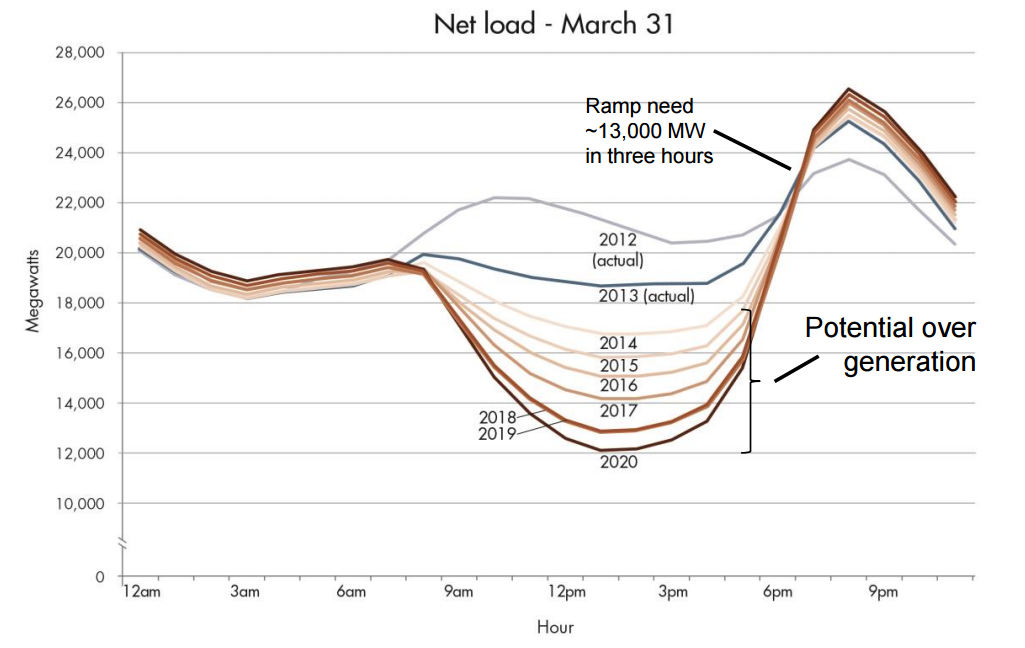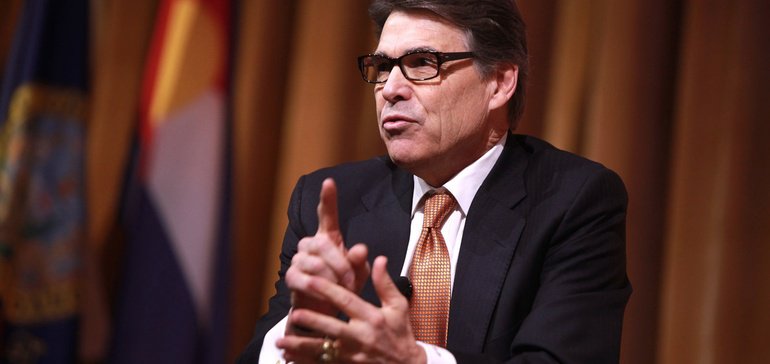In a letter to the Department of Energy, Secretary Perry describes having attended the G7 Energy Ministerial, and his reaction to discussion of “the need for an energy transition utilizing greater efficiency and fuel diversity.” That transition is necessary because the prevailing electric energy paradigm is based in fossil fuels, primary coal, which we know very well causes huge environmental and climate harm. There is clearly an urgent need to transition away from that stuff, while at the same time ensuring the electricity grid is stable.
What is Secretary Perry’s response? It’s to ask whether renewable energy resources threaten coal-fired electricity generation’s capacity to provide baseload electricity.
As Secretary Perry notes, the stability of our society is due in part to electricity grid stability. We can reliably turn on the lights and keep food in the fridge and so on because of that. His letter claims “We are blessed as a nation to have an abundance of domestic energy resources, such as coal, natural gas, nuclear, and hydroelectric, all of which provide affordable baseload power and contribute to a stable, reliable and resilient grid.” The letter goes on to describe how those energy resources are under threat because of “regulatory burdens introduced by previous administrations” that killed jobs and all that stuff.
The letter![]() requires a report within 60 days exploring federal policies regarding the changing electric fuel mix, the compensation in wholesale energy markets, and whether “regulatory burdens” are forcing the premature retirement of “baseload power plants.”
requires a report within 60 days exploring federal policies regarding the changing electric fuel mix, the compensation in wholesale energy markets, and whether “regulatory burdens” are forcing the premature retirement of “baseload power plants.”
Please – someone get Secretary Perry a clue or three.
First, does he understand the future cost of the climate and environmental problems due to coal and other forms of dirty electricity? The USA has lots and lots of vital public infrastructure at sea level, highways, bridges, ports, cities, airports, etc, all of which are due to be flooded as sea level rises. That’s just one example of the future cost of climate change, and there are plenty more. Wouldn’t it be wise governmental planning to put into place policies that avoids those future expenses?
Second, ..well..
Providing Baseload Electricity
The big fallacy in the letter is to assume the only way to provide baseload electricity is with coal or natural gas or nuclear plants. Yes, that’s how baseload power is currently provided, but that’s not the only way to do so.
What’s baseload power? It’s the electricity that is always available. At 3AM when you turn the lights on to take a pee or because you need to get up early for a special trip or something, that electricity is provided by baseload generation sources. During the day when electricity demand rises, other generation sources kick in. The baseload resources run 24 hours a day seven days a week.
The critique of most renewable energy sources is that they’re intermittent, and therefore they cannot provide baseload services, and therefore the role of solar or wind has to remain marginalized.
New energy storage technology is changing the landscape. It’s now possible to make different decisions. For example, falling prices for lithium-ion batteries are making it more feasible to deploy huge battery packs to store excess electricity at one time of day, releasing it at other times of day.
The advent of affordable 200+ mile range electric cars is a side effect of falling battery prices. That the automakers can afford to sell a 60 kiloWatt-hour electric car for $35,000 MSRP concretely demonstrates falling battery prices. Tesla’s Gigafactory is a gambit to rapidly force battery prices downward to sell not only electric cars but other energy systems, now that Tesla is merging with Solar City.
The general model we must embrace was demonstrated by the Solar Impulse electric airplane. Last fall the Solar Impulse completed its around-the-world flight. With a combination of solar panels embedded in every aircraft surface, and energy storage units, the Solar Impulse flew for up to 6 days at a stretch, without using a drop of any fuel. Every day the Solar Impulse gathered enough solar power to fly not only throughout the day, but all through the next night. The only limitation was human endurance, since the Solar Impulse pilot had to stay alert through the whole flight. The aircraft itself could fly indefinitely, since it gathers enough power during the day to fly all night long.
That’s what our cities need to do. Have enough energy gathering equipment to capture enough energy from wind and solar to remain powered throughout the night. It will be a long process of reimplementing the grid to do that. Instead of killing jobs, the renewable energy system is creating the jobs required to implement that transformation. Far more new jobs are created than would be preserved by preserving the fossil fuel system.

I know conditions in California the best. California has over half of all solar electricity deployment in the USA. As I noted recently California is beginning to experience The Duck Curve problem, namely the abundance of solar electricity generated during the day is driving down the daytime wholesale electricity prices, and sometimes the price goes negative during the day.
California’s response is not to rush back to Coal or Natural Gas. Instead it’s to encourage energy storage systems, and in general a restructuring of the electricity grid. The future electricity grid in California, if plans unfold as the Public Utilities Commission envisions, is a multi-way electric grid with many players besides the traditional electricity utilities. Some will store and release electricity as required throughout the day, others will schedule electricity consumption for advantageous times of the day.
For example, consider a hot summer day where the electricity grid planners can easily predict that by 3PM all the air conditioners will be cranked up to 11. They know electricity demand will be high. A company could offer a service of scheduling electric car charging so it occurs at a different time of day. Another company could schedule air conditioning so that buildings are pre-cooled before the heat of the afternoon. Another company could pre-schedule hot water heating, or pre-schedule the refrigerators in food storage warehouses, and on and on.
In other words, the electricity grid could be orchestrated to timeshift both electricity production and electricity demand to better coincide.
At the moment solar electricity production prices are falling rapidly and is typically cheaper than natural gas or coal plants. That’s an economic fact that should be driving more and more solar (and wind) deployment. Their intermittency can be solved by a combination of scheduling electricity demand for when those sources produce electricity, and by storing excess electricity to be released later.
California’s electricity utilities and Public Utilities Commission are working closely with renewable energy technology providers — solar inverter makers — energy storage makers — and others — to define the communication protocols and systems required to orchestrate which parts of the system turn on or off at what times of the day.
THAT is California’s goal.
- Is there enough Grid Capacity for Hydrogen Fuel Cell or Battery Electric cars? - April 23, 2023
- Is Tesla finagling to grab federal NEVI dollars for Supercharger network? - November 15, 2022
- Tesla announces the North American Charging Standard charging connector - November 11, 2022
- Lightning Motorcycles adopts Silicon battery, 5 minute charge time gives 135 miles range - November 9, 2022
- Tesla Autopilot under US Dept of Transportation scrutiny - June 13, 2022
- Spectacular CNG bus fire misrepresented as EV bus fire - April 21, 2022
- Moldova, Ukraine, Georgia, Russia, and the European Energy Crisis - December 21, 2021
- Li-Bridge leading the USA across lithium battery chasm - October 29, 2021
- USA increasing domestic lithium battery research and manufacturing - October 28, 2021
- Electrify America building USA/Canada-wide EV charging network - October 27, 2021





















This guy Perry is DUM AS A ROCK. He is doing exactly what his puppeteers BIG OIL has instructed him to do. BIG OIL probably wrote the letter for him.
It may be there is conspiracy/corruption going on. I want to focus on the positive-direction-results we want to achieve, since it’s so compelling.
David, as ever, a great article. Yet somehow you’ve not mentioned the Koch brothers. Let’s say, for the sake of argument, that Perry has shit for brains, is eager to do the bidding of the evil-minded, and is grasping for an excuse to kill renewable energy. Well, then, if the eagerness part is true, and the grasping part is true, then the shit for brains part doesn’t matter, does it? I generally use the argument that you shouldn’t assume conspiracy where incompetence will provide an equally valid explanation: here, I prefer the argument to not ascribe to ignorance that which can be equally explained by nefariousness.
I’m trying to focus on the positive-direction-results we want. There are clear compelling reasons to head in the direction of distributed energy storage and distributed renewable energy resources. What Perry is pushing for, whether its in collusion with Big Oil or Big Coal, is a very bad idea that is not at all compelling.
One tactic to fight this is to explore whether there IS collusion or corruption … right? But by sticking to the compelling story is useful as well.
You and I agree the reasons are clearly compelling. But if others don’t see these reasons, then either they are not so clear, or their vision has been corrupted. You tell me what the head of DOE should be able to see.